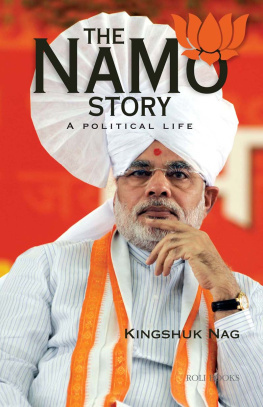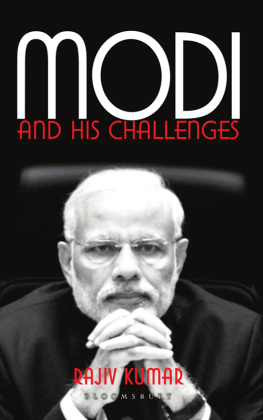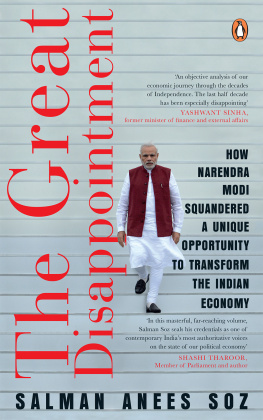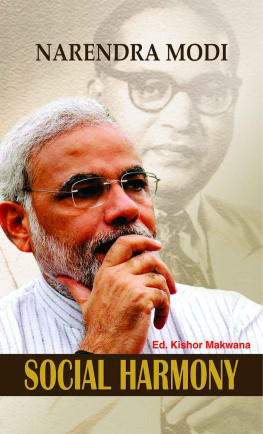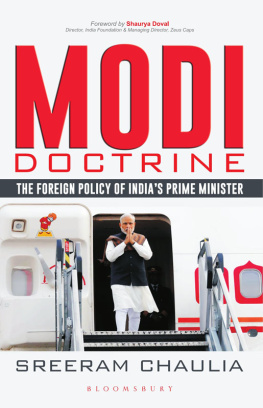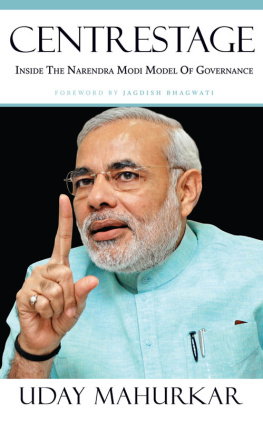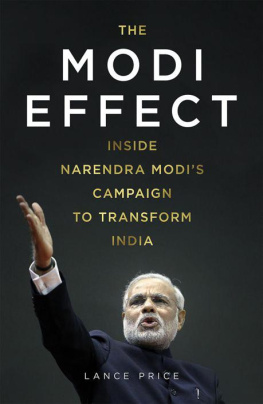
MODI
DEMYSTIFIED
The Making of a Prime Minister

RAMESH MENON

HarperCollins Publishers India
Contents
I t was a hot and muggy evening on 26 May 2014 when Narendra Modi was sworn in as the Prime Minister of India in front of an audience of 4,000 in the decked-up forecourt of Rashtrapati Bhavan. In attendance were the leaders of seven South Asian nations, as also Sonia Gandhi, Rahul Gandhi and Modis predecessor Manmohan Singhthe Congress trinity that he had fought tooth and nail in his fight for the countrys most powerful chair. Standing up there, before all those mighty and dignified guests who were present to take part in the most important moment of his life, he could have scarcely been unaware of his own pre-eminence.
The command of his singular name had seen his Bharatiya Janata Party (BJP) through the nine months of electoral campaigning to the clearest majority a non-Congress party had won since independence in the Lok Sabha, the lower house of parliament. His rise marked a paradigm shift in the muddy Indian political scene that for years had limped on fractured mandates. Interestingly, at forty-five, he had one more member in his council of ministers than the Congress had in the Lok Sabha from all over the country. The Modi wave had decimated the party that had been in power for a decade. It had also showed that the electorate no more voted on the basis of caste and religion and wanted change. In India, where the dream of emerging as a world power had waned, there was hope again. The country had voted for it, and Modi must have basked in the knowledge that it was he who had inspired it.
But a greater reason for him to be pleased with himself must have been that he had not risen to power on the strength of a dynasty or an elite education like his opponents. For the most part of the last thirteen years he had spent as the chief minister of the state of Gujarat, he had in fact been considered a pariah both nationally and internationallysomeone who was denied a visa by the United States for the riots that had taken place on his watch in 2002, and someone who was cited by partners as the reason for the breaking-up of alliances with the BJP.
And then suddenly, the party was in a position to generously embrace allies when it didnt need any. Suddenly, there were accolades from all over the world. The Economist magazine, which only a month previously had refused to endorse him for the prime ministers post because of his checkered past, said that his amazing victory gave India its best chance ever of prosperity, saying it would be good for India and the world. There was a new straw in the wind. World leaders congratulated him, and the United States too showed a willingness to engage with him.
Having secured an extraordinary mandate, he was all set to chart a new path, a new history. Like all things he had done before, he turned his swearing-in too into a spectacle by ensuring the presence of the heads of governments of Afghanistan, Bangladesh, Bhutan, Maldives, Nepal, Sri Lanka and, most notably, Pakistan. It was something no prime minister had tried to do before. He wanted to signal that he had hit the ground running and was willing to face sticky issues like foreign policy, even with regards to Pakistan, head-on. He held one-on-one meetings with the leaders soon after taking charge. Fresh from a belligerent campaign, he moved effortlessly into the role of a statesman.
On the domestic front, he cast himself in that mould by switching to a conciliatory tone. In his first public meeting after emerging triumphant in the elections, he spoke of his commitment to govern the country in the spirit of the Constitution. He said he would serve India like his mother and termed himself the nations Mazdoor No. 1, the most dedicated of workers. He said he would take everyone along, even those opposed to him, for a government did not belong to a political party but to all the people and he wanted to serve everyone equally. Gone were his aggressive body language, the barbed sarcasm of his public speeches and the personal attacks on his opponents. For the first time, he even broke down in public during his acceptance speech at the BJPs parliamentary board meeting on 20 May.
Going ahead, if his era in Gujarat is any indicator, Modi will seek to recast himself as a moderate politician with a larger vision for the future. He will speak only of growth, progress and development, not of a Ram temple or of Hindutva. One of the first things he did even before being sworn in was to request the secretaries of key ministries to make short and focused presentations on the challenges his government faces. Given his huge mandate, he will also take tough decisions and stand by them. But he will be equally aware of the mammoth responsibility on his shoulders and the arduous job he has at hand. As of June 2014, as this book goes to press, Indias economic growth has slowed down, inflation is high, the fiscal situation is poor and unemployment levels are worrisome. It is to correct this situation that the country has voted Modi to power, and his honeymoon period will be brief. People are hungry for change. The young want jobs, more transparent governance and a better quality of life.
He will have to define his much-touted Gujarat model, which led to much intellectual debate during the elections. While Nobel Prizewinning economist Amartya Sen felt that Modis single-minded focus on industrial growth and business had ignored human development indicators and the welfare of minorities and the less well-off, another renowned economist, Jagdish Bhagwati, said that Modis approach would generate wealth which would eventually lift millions out of poverty. On the national stage now, he will have to see if the approach that worked in Gujarat, which was for decades before him too known for its entrepreneurial spirit and for being a well-to-do state, will work in the rest of the country with greatly different requirements.
There is another growth model Modi greatly admires, that of China. The country bowled him over when he visited it for the first time along with a delegation of businessmen from Gujarat. He made four such visits as he sees China not as a rival but as an opportunity. He has a good equation with the neighbour, which welcomed him while he was shunned by global powers, and managed to attract Chinese investments into Gujarat. The Chinese leadership too hailed his victory at the national stage, and he could actually become a game changer if he uses his ingenuity to forge a new economic partnership beneficial to both. But, as prime minister, he will have to view China also as a competitor, with comparisons likely to be drawn between the economies of the two Asian giants constantly.
In the din of nationwide celebrations, Modi must have already realized how lonely it is at the top as he wears a heavy crown. He has no magic wand but will have to deliver fast to ensure that the numerous promises he made during the whirlwind election campaign are fulfilled. Soon, slogans will be forgotten and knives will be out, sharp ones within the party itself. The BJPs old guard and the Rashtriya Swayamsevak Sangh (RSS), the partys right-wing parent body, will have to be kept in good humour. Long pending legislation will have to be pushed through, corruption curbed and the economy revived. Neighbours will have to be won over and, despite the majority in the Lok Sabha, regional satraps will have to be lured to gain leverage in the Rajya Sabha, the upper house of parliament, and state assembly elections.
Next page

